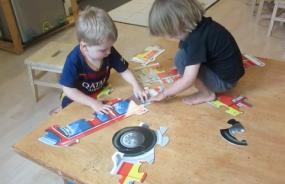Strategies for Putting a Puzzle Together

Ethan and Kai, 3 years, work for 7.5 minutes to complete a large puzzle of a fire truck. The pieces are large enough for the boys to see printed on the piece most of a recognizable part of the fire truck, such as half of a tire, most of a window. The pieces themselves have been cut in the usual form, with pips that are inserted into curves so that the pieces interlock. The boys have several strategies they can use to find the correct place to insert a given piece. Since they know what a whole fire truck should look like, they can figure in which quadrant of the whole puzzle a recognizable part belongs. A piece that has part of a window printed on it would likely go toward the top right, given the fire truck is facing to the right. A wheel piece would most likely go toward the bottom half, either on the right or left, since there are two tires on this side view of the fire truck. Call this strategy locating a part using knowledge of the whole picture.
The boys can use a more local strategy of color continuity between a piece in their hand and pieces already assembled on the table. If Ethan is holding a piece with a black segment, he could move that piece to the assembled pieces on the table where there are other black segments. Call this strategy the color continuation strategy. With adult puzzles color continuity is the predominant strategy, except for sorting out the straight edge pieces.
Sometime the boys look at the physical shape of a piece and try to insert the pip of that piece into a curved cut out that looks like the same shape. The puzzle was cut so that each piece only fits in one space, so this strategy would not lead to an incorrect fit, but it would lead to many failed attempts to fit a piece.
When you look at the video keep track of all three of these strategies. Do both boys use the same strategies? Would you agree that using knowledge of the whole picture was the most effective, or was this true only toward the end of the video when more of the picture was completed? Do you agree that looking at the physical shape of the piece drove the first attempt at placing a piece, or did attention shift to the physical shape only when a piece, known to go in a spot had to be rotated? What might cause a child to be a piece-fitter rather than a space-filler? A piece-fitter would hold on to a piece and try it in several different places before using a different piece. A space-filler would look at a hole in the group of assembled pieces and try one piece and then another and then another in that same hole. Can you think of what type of puzzle would cause the children to shift from piece-fitting to space-filling? What about a puzzle that has no picture, just a solid color? What role did language play? Did the children name a part of the fire truck only after they created that part, or did they name a part that they were trying to complete? What about the ending when they knew there were more pieces, even though they could not see them? And what do you make of the fact that as soon as they finished the fire truck they were no longer interested in what they had done?
When one slows down to watch these strategies you get the full force of what children know. The process reveals their intelligence, the way they work together, how they learn from a misplaced piece, how the skill of one child helps the other child. Thus is the power of video.
Keywords: threes, child-child, spatial relations, persistence
Length of video: 7 minutes 33 seconds
